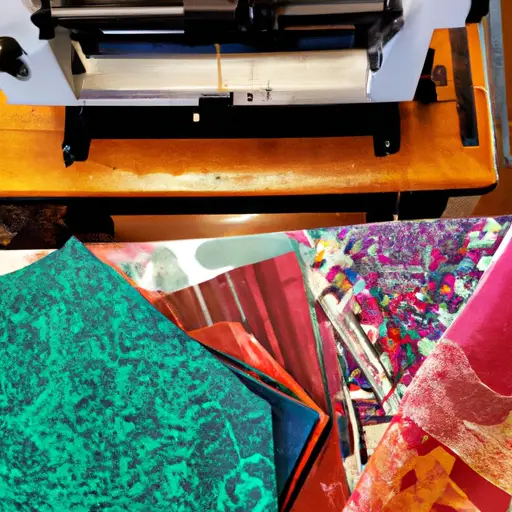The world of textiles is a vast and diverse one, with countless possibilities for creating unique and personalized designs. If you have a subconscious desire for innovation and want to level up your textiles, then learning DIY screen printing and block printing techniques is the perfect way to do so.
These techniques allow you to transform plain fabrics into works of art, adding a touch of creativity and individuality to your projects.
Screen printing is a versatile technique that involves transferring ink onto a surface through a stencil. By mastering this art, you can create intricate designs with crisp lines and vibrant colors. Whether you want to print patterns on t-shirts, tote bags, or home decor items, screen printing opens up a world of possibilities.
On the other hand, block printing is a traditional method that involves carving a design onto a block of material, such as wood or linoleum, and then using that block to stamp the pattern onto fabric. This technique allows for more organic and handcrafted designs, perfect for adding a rustic touch to your textiles.
By learning both screen printing and block printing techniques, you will have a wide range of tools at your disposal to unleash your creativity and take your textiles to the next level.
So, let’s dive in and discover the exciting world of DIY printing techniques that will elevate your textile projects to new heights.
Getting Started with Screen Printing
Screen printing, a popular technique in textile design, involves the process of transferring ink through a mesh screen onto a substrate, resulting in vibrant and precise patterns or designs.
This method offers endless possibilities for creating unique and eye-catching textiles.
The process begins with creating a stencil, which is then attached to a mesh screen.
The screen is carefully aligned with the substrate, whether it be fabric or paper, and ink is applied to the top of the screen.
A squeegee is then used to spread the ink across the screen, forcing it through the open areas of the stencil and onto the substrate below.
The result is a beautifully printed design that can be repeated multiple times with consistent accuracy.
One of the advantages of screen printing is its versatility.
It allows for the use of a wide range of inks, from opaque to transparent, and can be used on various substrates, including cotton, silk, and even wood.
This flexibility enables textile designers to experiment with different materials and effects, pushing the boundaries of traditional textile design.
Additionally, screen printing allows for precise and intricate designs to be reproduced with ease, making it an ideal technique for creating intricate patterns or detailed imagery.
The vibrant colors and sharp lines achieved through screen printing make it a favorite among designers looking to make a bold statement with their textiles.
Whether used for fashion, home décor, or art, screen printing offers endless possibilities for those looking to level up their textile designs and bring their creative visions to life.
Mastering the Art of Block Printing
Mastery of the art of block printing involves developing a deep understanding of the intricate techniques required to create intricate and visually captivating designs on various textile materials.
Block printing is a traditional method that involves carving a design onto a block of wood or linoleum and then using that block to transfer the design onto fabric or paper.
The process requires meticulous attention to detail, as the artist must carefully carve the block to create the desired design.
The level of skill and precision required to master block printing is truly remarkable, as each design must be carved with precision and accuracy to ensure that it transfers onto the fabric or paper in a clean and clear manner.
In addition to the technical skills required, mastering block printing also involves a deep understanding of color theory and composition.
The artist must carefully consider the placement of each element in the design, as well as the colors that will be used.
The layering of colors is an essential part of the block printing process, and the artist must have a keen eye for blending and harmonizing colors to create visually stunning designs.
Furthermore, the artist must also consider the texture and weight of the fabric or paper being used, as different materials require different printing techniques to achieve the desired result.
Overall, mastering the art of block printing is a labor-intensive and time-consuming process, but the end result is a beautifully crafted piece of art that showcases the artist’s skill and creativity.
Choosing the Right Materials for Your Projects
When selecting materials for your block printing projects, it is crucial to consider the texture and weight of the fabric or paper being used to ensure optimal results in capturing the intricate designs.
The texture of the material plays a significant role in how well the ink adheres to the surface and how fine the details of the design can be. Smooth fabrics, such as silk or cotton, are ideal for achieving crisp and clean prints, as they provide a smooth surface for the ink to spread evenly. On the other hand, fabrics with a rough texture, like linen or burlap, may result in a more rustic and imperfect print, which can add character to certain projects.
Similarly, when working with paper, choosing a smooth and sturdy type, such as bristol or watercolor paper, will ensure that the ink is absorbed evenly and does not bleed or smudge, resulting in a professional-looking print.
The weight of the material also affects the outcome of the block printing project. Lighter weight fabrics, like chiffon or organza, are more delicate and may require extra care when printing to avoid tearing or distorting the design. However, they can create a beautiful and ethereal effect when printed with a light touch. On the other hand, heavier fabrics, such as canvas or denim, are more durable and can handle a more forceful printing technique, allowing for bolder and more vibrant prints.
When working with paper, a heavier weight will provide more stability and prevent the paper from curling or warping during the printing process. By carefully considering the texture and weight of the materials, artists and crafters can ensure that their block printing projects turn out beautifully and showcase the intricate designs they have worked so hard to create.
Exploring Advanced Techniques and Designs
Exploring the realm of advanced block printing techniques and designs unveils a world of creative possibilities and intricate patterns that can transform ordinary fabrics or papers into stunning works of art. This level of expertise goes beyond the basics of block printing and delves into more complex methods that require a deeper understanding of the craft.
Advanced techniques such as layering, gradient effects, and multi-color registration open up a whole new dimension for artists and designers to explore. Layering is a technique that involves printing multiple layers of colors or designs on top of each other to create depth and dimension in the final piece. By carefully aligning each layer, artists can achieve complex and visually striking compositions.
Gradient effects, on the other hand, allow for smooth color transitions and shading within a single block print. This technique requires a keen eye for color blending and careful control of ink application.
Lastly, multi-color registration involves the precise alignment of different blocks to create intricate patterns and designs. This technique requires a high level of skill and precision, as any misalignment can result in a distorted final image.
By mastering these advanced block printing techniques, artists can push the boundaries of their creativity and produce truly innovative and captivating designs. The possibilities are endless, from creating intricate floral patterns to capturing the essence of landscapes or even experimenting with abstract forms.
Advanced block printing techniques allow for a level of intricacy and detail that can rival other art forms, making it a truly versatile and expressive medium for artists to explore. Whether it’s adding depth and dimension through layering, achieving seamless color transitions with gradient effects, or creating complex patterns with multi-color registration, advanced block printing techniques offer a world of artistic possibilities waiting to be explored.
Conclusion
In conclusion, learning DIY screen printing and block printing techniques can be a rewarding and creative endeavor for anyone interested in textiles. By getting started with screen printing, individuals can explore the art of transferring designs onto various surfaces, allowing for endless possibilities in creating unique and personalized pieces.
By mastering the art of block printing, one can delve into the world of intricate designs and patterns, using simple tools to achieve stunning results. Choosing the right materials for your projects is crucial in achieving professional-looking prints. From selecting the right type of screen and ink to understanding the different options for blocks and carving tools, attention to detail is key.
By exploring advanced techniques and designs, individuals can push the boundaries of their creativity, experimenting with layers, textures, and color combinations. Whether it’s creating custom clothing, home decor items, or even artwork, DIY printing techniques offer a world of possibilities for expressing oneself through textiles.
In conclusion, DIY screen printing and block printing techniques provide an exciting avenue for individuals to level up their textile skills and create unique and personalized pieces. With the right materials and a willingness to explore advanced techniques, individuals can unlock their creative potential and produce stunning prints. Whether it’s for personal projects or professional endeavors, the art of printing offers a world of possibilities for expressing oneself through textiles.
So why not embark on this journey and discover the joy of DIY printing today?
 printablelabelstemplate
printablelabelstemplate
